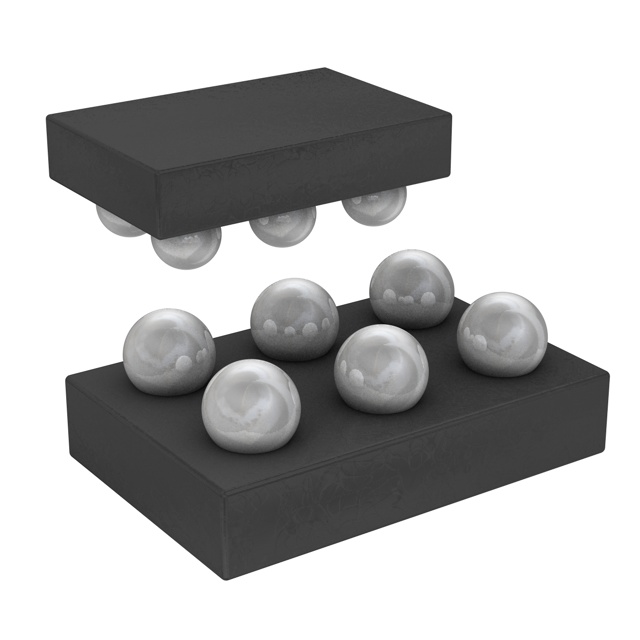FPF2026 - English Editing Encyclopedia Entry
Product Overview
Category: Integrated Circuit (IC)
Use: Power Management IC
Characteristics: - Low power consumption - High efficiency - Compact size - Wide input voltage range
Package: QFN (Quad Flat No-leads)
Essence: FPF2026 is a power management IC designed for efficient power distribution and control in various electronic devices.
Packaging/Quantity: The FPF2026 is typically sold in reels of 2500 units per reel.
Specifications
The FPF2026 has the following specifications:
- Input Voltage Range: 2.7V to 5.5V
- Output Voltage Range: 0.8V to VIN
- Maximum Continuous Current: 1.5A
- Quiescent Current: 20µA (typical)
- Operating Temperature Range: -40°C to +85°C
Detailed Pin Configuration
The FPF2026 features a 10-pin configuration as follows:
- EN (Enable): Enable pin for turning the IC on/off.
- GND (Ground): Ground reference for the IC.
- VIN (Input Voltage): Input voltage supply for the IC.
- VOUT (Output Voltage): Output voltage from the IC.
- PG (Power Good): Indicates the status of the output voltage.
- FB (Feedback): Feedback pin for regulating the output voltage.
- SS (Soft Start): Soft start capacitor connection.
- BST (Bootstrap): Bootstrap capacitor connection.
- SW (Switch Node): Switching node connection.
- LX (Inductor Connection): Connection to the inductor.
Functional Features
The FPF2026 offers the following functional features:
- Overcurrent protection
- Undervoltage lockout
- Thermal shutdown protection
- Soft start functionality
- Power good indicator
Advantages and Disadvantages
Advantages: - Low power consumption enhances battery life. - High efficiency reduces power dissipation. - Compact size allows for space-saving designs. - Wide input voltage range accommodates various power sources.
Disadvantages: - Limited maximum continuous current may restrict high-power applications. - Operating temperature range may not be suitable for extreme environments.
Working Principles
The FPF2026 operates as a buck converter, converting a higher input voltage to a lower output voltage. It utilizes pulse-width modulation (PWM) techniques to regulate the output voltage based on the feedback received from the FB pin. The integrated protection features ensure safe operation and prevent damage to the IC and connected devices.
Detailed Application Field Plans
The FPF2026 finds applications in various electronic devices, including but not limited to: 1. Mobile phones 2. Tablets 3. Portable media players 4. Wearable devices 5. IoT devices
Detailed and Complete Alternative Models
- FPF2027: Similar to FPF2026 with higher maximum continuous current of 2A.
- FPF2028: Similar to FPF2026 with wider input voltage range of 2.5V to 6V.
- FPF2029: Similar to FPF2026 with additional overvoltage protection feature.
These alternative models provide flexibility in choosing the appropriate power management IC based on specific requirements.
In conclusion, the FPF2026 is a power management IC that offers low power consumption, high efficiency, and compact size. Its wide input voltage range and integrated protection features make it suitable for various electronic devices. While it has limitations in terms of maximum continuous current and operating temperature range, alternative models are available to cater to different application needs.
Lista 10 Vanliga frågor och svar relaterade till tillämpningen av FPF2026 i tekniska lösningar
Sure! Here are 10 common questions and answers related to the application of FPF2026 in technical solutions:
Q: What is FPF2026? A: FPF2026 is a type of Field-Programmable Filter (FPF) integrated circuit commonly used in technical solutions for signal processing.
Q: What are the key features of FPF2026? A: The key features of FPF2026 include low power consumption, high-speed operation, programmability, and compatibility with various signal processing applications.
Q: How can FPF2026 be used in technical solutions? A: FPF2026 can be used as a filter in audio processing, image processing, sensor data filtering, and other applications where signal conditioning or noise reduction is required.
Q: Is FPF2026 compatible with different microcontrollers or processors? A: Yes, FPF2026 is designed to be compatible with various microcontrollers and processors, making it easy to integrate into different technical solutions.
Q: Can FPF2026 be programmed to adapt to different filtering requirements? A: Yes, FPF2026 is programmable, allowing users to configure its filter characteristics such as cutoff frequency, gain, and filter type to meet specific requirements.
Q: What is the power consumption of FPF2026? A: FPF2026 is known for its low power consumption, typically operating at a few milliwatts, making it suitable for battery-powered devices.
Q: Does FPF2026 support real-time signal processing? A: Yes, FPF2026 is capable of real-time signal processing due to its high-speed operation, enabling it to process signals in real-time without significant delay.
Q: Are there any development tools or software available for programming FPF2026? A: Yes, the manufacturer of FPF2026 provides development tools and software that allow users to program and configure the filter settings of the IC.
Q: Can FPF2026 be used in both analog and digital signal processing applications? A: Yes, FPF2026 can be used in both analog and digital signal processing applications, providing flexibility in various technical solutions.
Q: Are there any limitations or considerations when using FPF2026 in technical solutions? A: Some considerations include the need for proper grounding and decoupling techniques, understanding the specific requirements of the application, and ensuring compatibility with other components in the system.
Please note that these questions and answers are general and may vary depending on the specific implementation and use case of FPF2026 in a technical solution.


